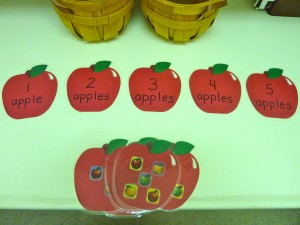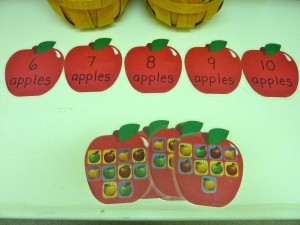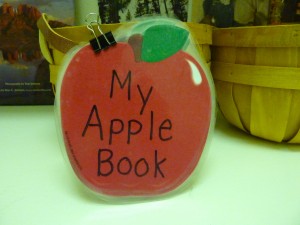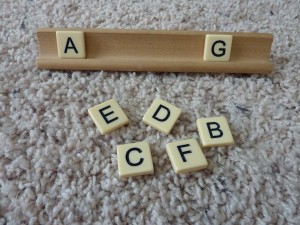Last week I shared how to make your own “Apple” book using a cute, thematic note pad and some basic facts about apples. Today I’d like to share some ways to use this same apple themed note pad (shown below) to build number skills.

My Obstacle Course Station Activity: Show How Many Apples
I created this activity a few years ago to help build Andrew’s understanding of numbers and the amounts that they represent. I decided to begin by combining the numbers with concrete items, in this case, red cotton puff “apples.” I wrote out the number and included the word “apple” on a page and provided the “apples” for him to distribute. At first we did this in order to build number sequencing and then I changed it up by only including some of the pages, not necessarily putting them in order from least to greatest. This allowed me to see if he understood what the numbers represented by showing me without needing to have intelligible speech to do so.
Note: I had a 6th grade teacher who was a stickler on labeling what it was we were referring to. If we didn’t state it as part of the answer, she would say, “5 what? Chickens?!” Her insistence on this has stuck with me I guess :).



My Obstacle Course Station Activity: Match the Sticker Card with the Correct Number
I like to start building math concepts with actual objects that he can physically manipulate to demonstrate his knowledge. Once I have a sense that he gets it, we move on. For this concept, we moved on to cards I made that had specific amounts of stickers on them. His job was to match up the sticker card with the number card. This would require him to count accurately in order to match them up properly.
This was so fascinating for me because I got to see how he approached counting – Was he pointing at each sticker or doing it in his head? Did he have a systematic approach or was it more random? Did he start from the top and move across or from the bottom and go up and around?
There were times when he would double count or skip a sticker and match the card up with the wrong one. Sometimes I would ask him if he was sure or ask him to count again but other times I would let him figure it out when he wound up with two sticker cards at the same number. If needed, I would bring out the “apples” for him to place on the stickers to see what the correct answer was. What started out as a really basic one to one correspondence activity turned out to give me a great deal of information and taught him some analyzing and problem solving skills.




This is an activity that takes no more than 10 minutes to create with a pad of paper, a marker, some puffs and/or stickers yet helps build some fundamental math skills.
Modification:
If this activity is too basic for your child, you can adapt it by writing equations on some and sums/differences/products/quotients on other pages for them to match up. I would also begin building these skills with items like the “apple” puffs that your child can manipulate to demonstrate their understanding of what they are being asked to do. I know that fact memorization is part of learning and I am glad that I don’t have to carry around puffs with me to figure things out as an adult (now picturing that cracks me up!) but it is really important that children have a good understanding of what equations mean.
Engage, Encourage and Empower!














